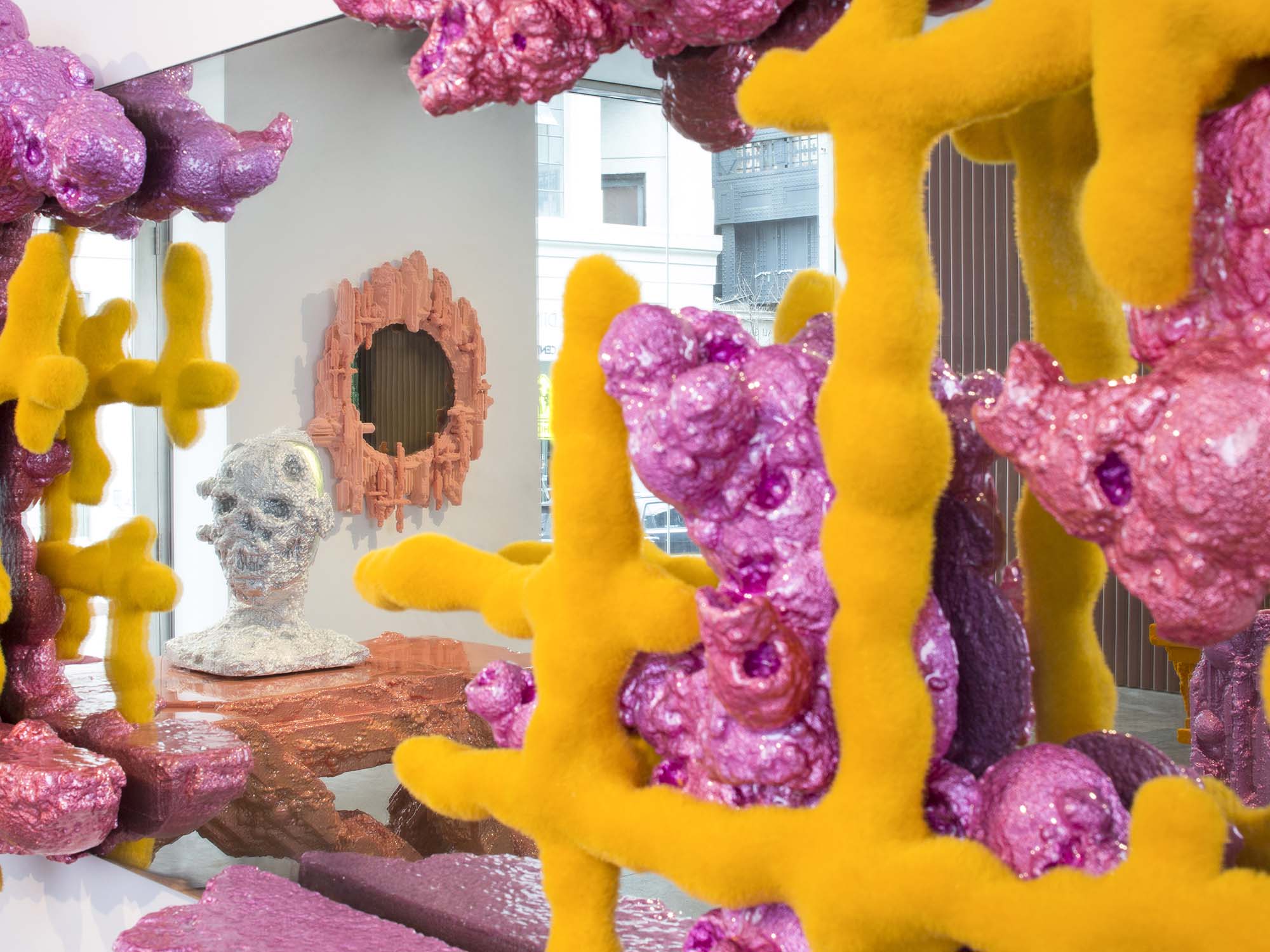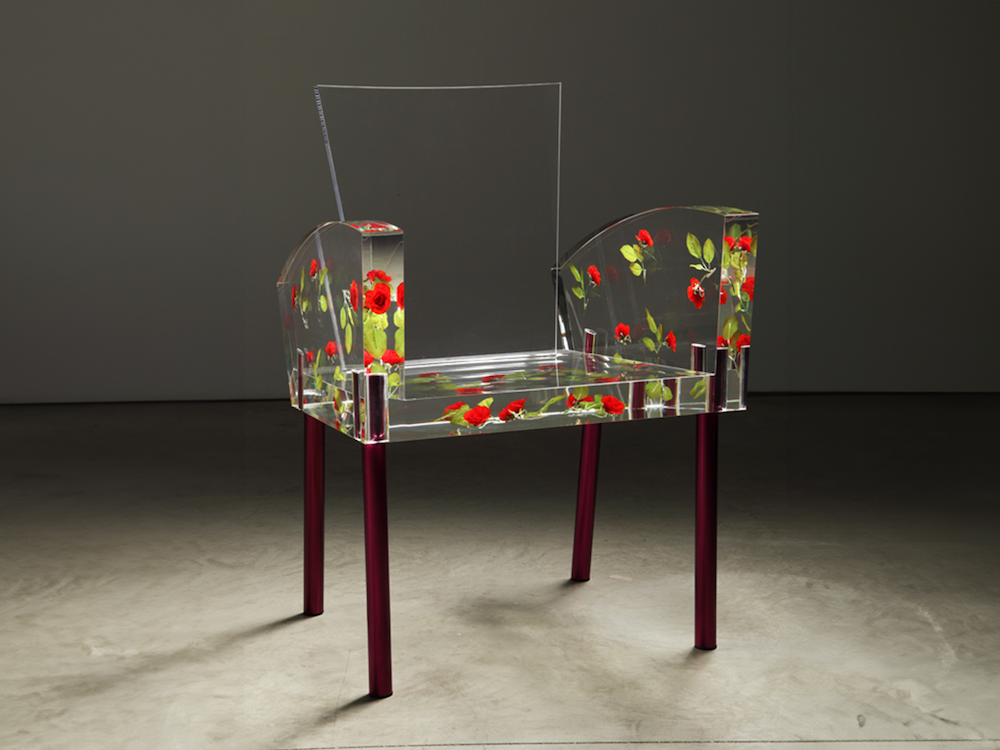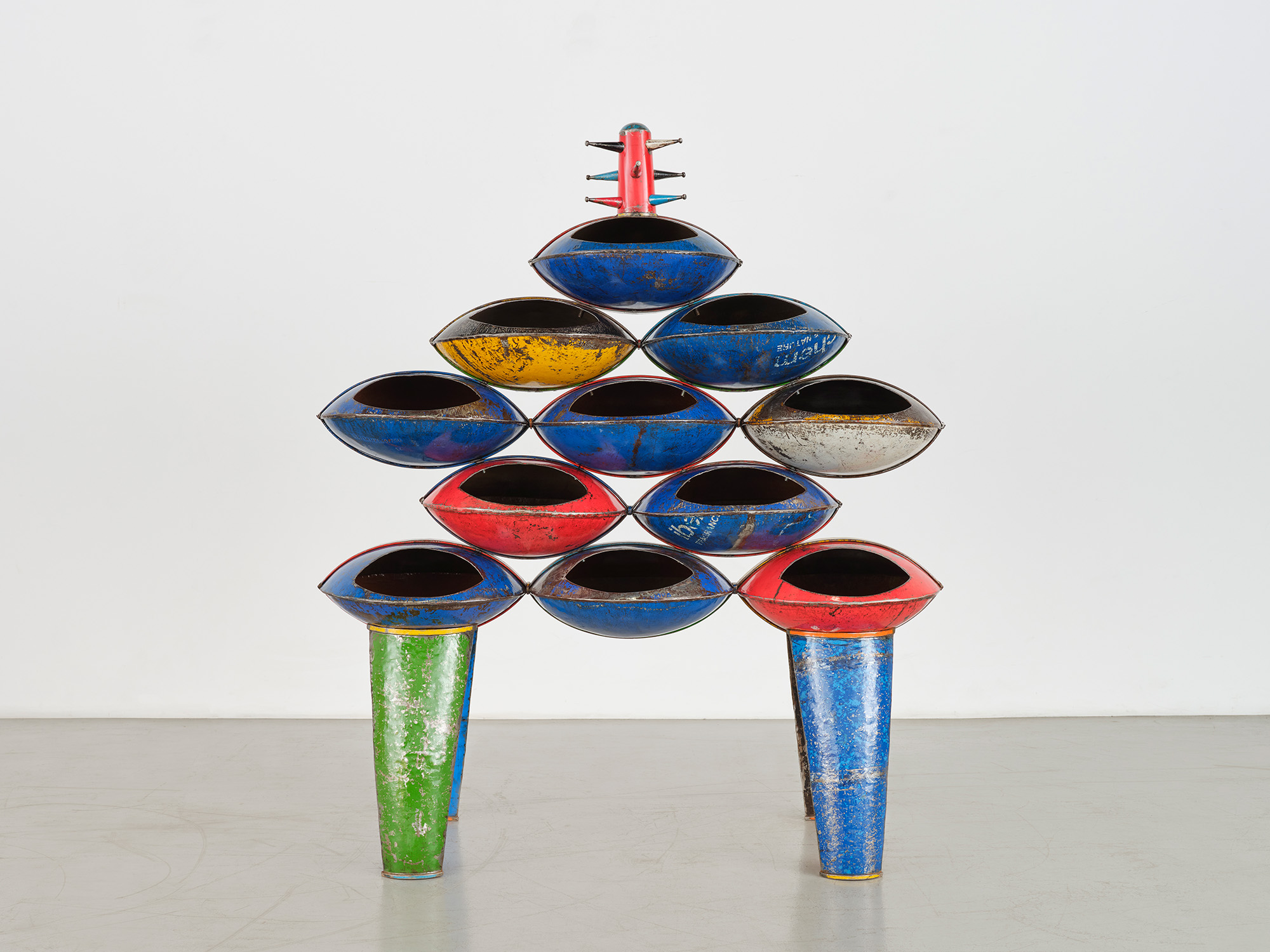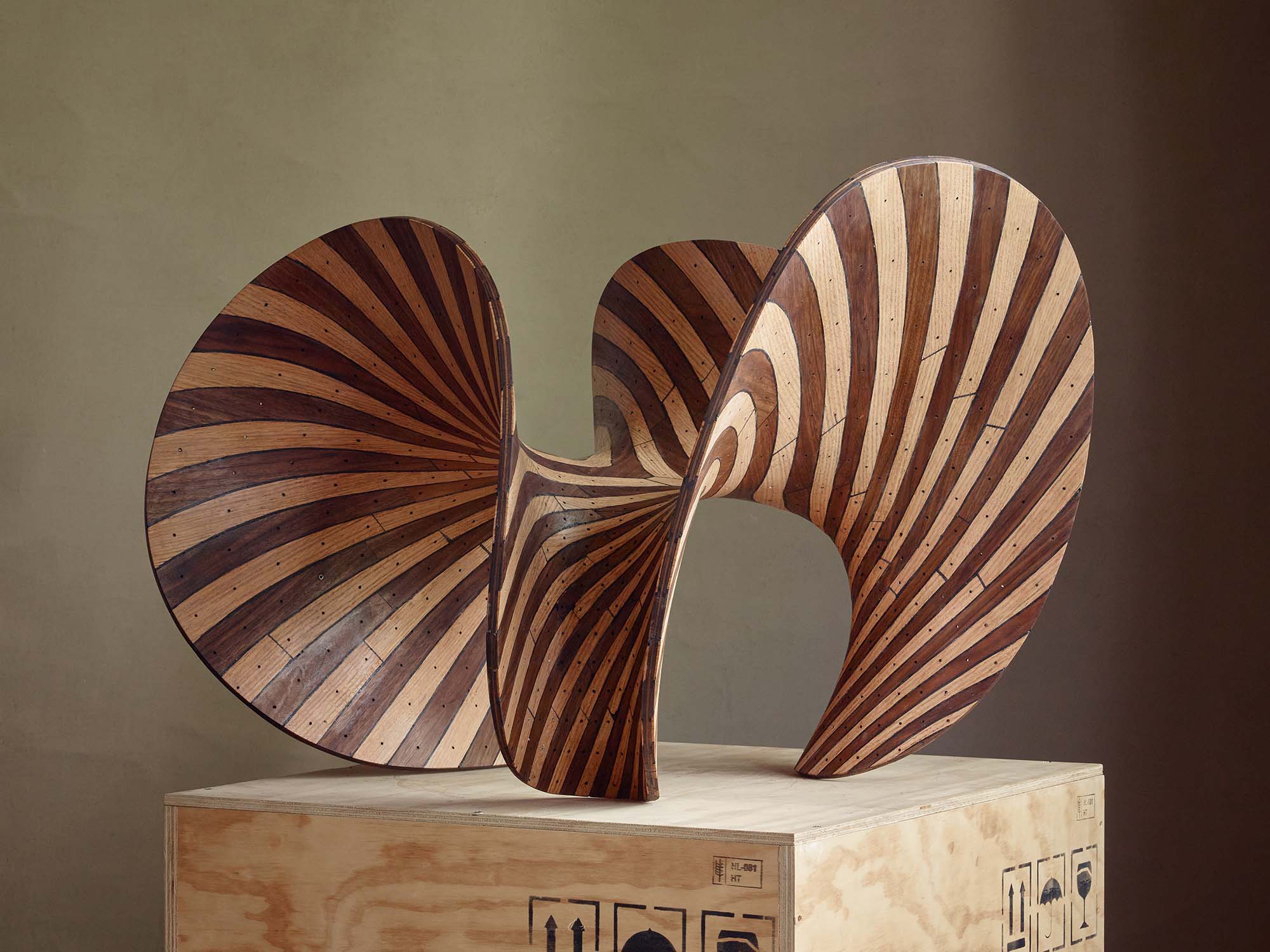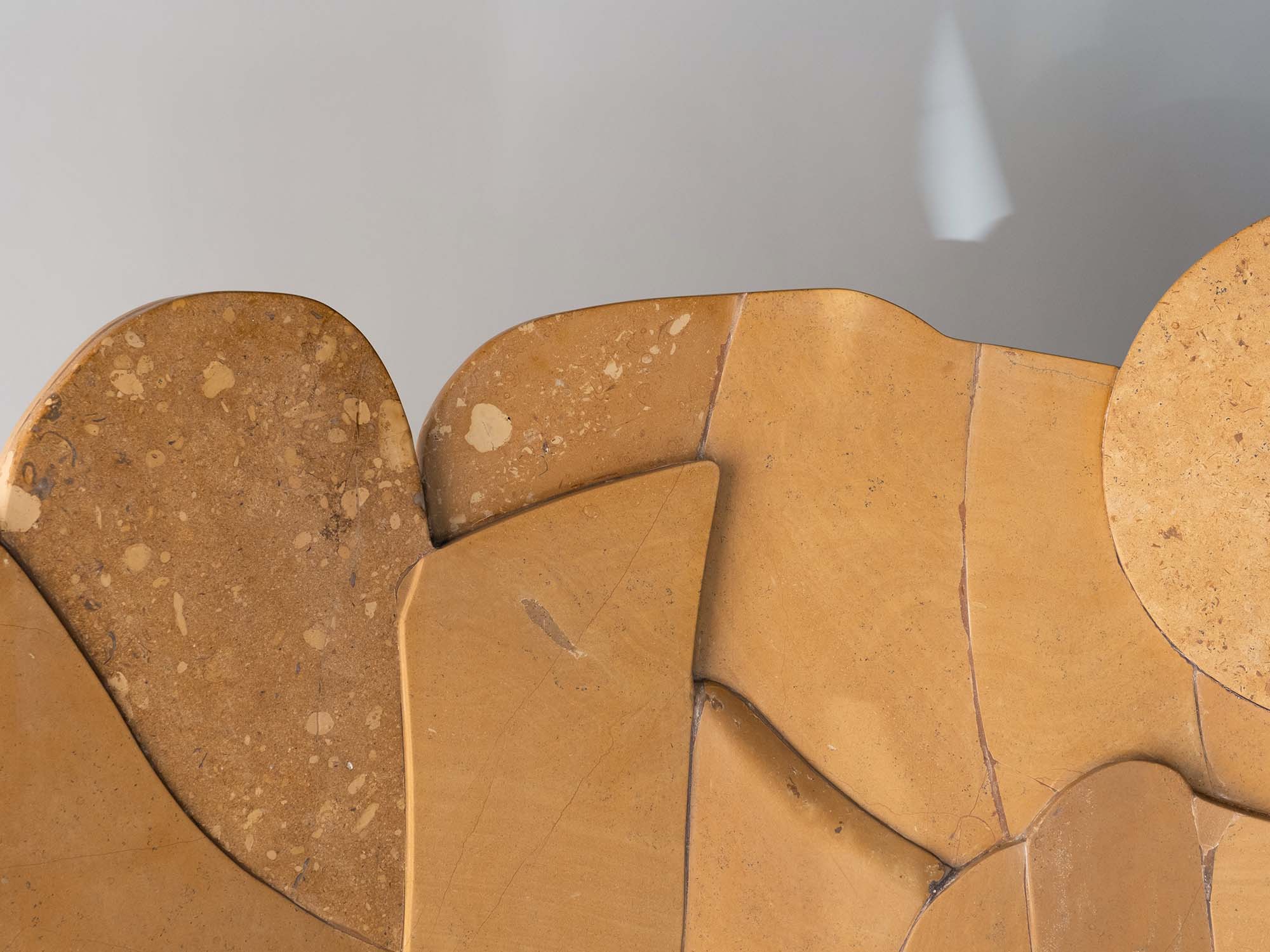By Glenn Adamson
On the wall of Chris Schanck’s studio in northeast Detroit is a handwritten sign, a relic of the building’s former use:
Jan. 6 1975
End of Svenska Tool
R.I.P.
The squat cinderblock structure was once the headquarters for a family-operated business – one of numerous small tool-and-die companies that serviced the enormous General Motors plant in the neighborhood. On one recent occasion a visitor stopped in, and told Schanck that it had been his family who owned Svenska. He shared his recollections of running around the shop as a little kid. “It’s good,” he said, “that things are still being made here.”
This was no idle comment. This neighborhood, near the border with the independently administered city of Hamtramck, shares the recent history of most of Detroit. Built up a century ago, when the auto industry was first revving its economic engines, it fell on hard times in the 1970s, and the slide has continued. All the markers of urban blight are here: abandoned houses, city services that are erratic at best. Just in the past couple of years though, the area’s residual proficiency at making stuff – and the cheap rents – have attracted a number of artists and entrepreneurs, of whom Schanck is one. It is not surprising that, for a returning former resident, just seeing the building occupied and productive was a cause for celebration.
Now, Schanck himself is not a Detroit native. He hails from Dallas, and originally came to Michigan to study at Cranbrook Academy, the elite art and design school in nearby Bloomfield Hills. Like many visitors, when he first moved to Detroit proper, he felt a guilty thrill at the dystopian landscape – a wide-open quality that reminded him of movies set after the apocalypse, which he had loved as a child. At first, it was his intention to keep more or less to himself. He could easily have become a poster boy for gentrification. Instead, he has undertaken something more complicated, more difficult, and far more inspiring: he has created a microcosm of the surrounding neighborhood.
Schanck’s commitment to the local started from sheer necessity. Even when he was in graduate school, he was developing a set of unusual fabrication methods, high on visual impact but extremely labor intensive. He remembers an occasion up at Cranbrook in which his friends gathered to help him make a desk, in exchange for pizza and beer. They were prototyping the bespoke technique he calls “Alufoil.” At that time, he simply built an armature by hand and then surfaced it with store-bought kitchen foil. A coat of resin made the object sturdy, and also brought out the gleam in the aluminum.
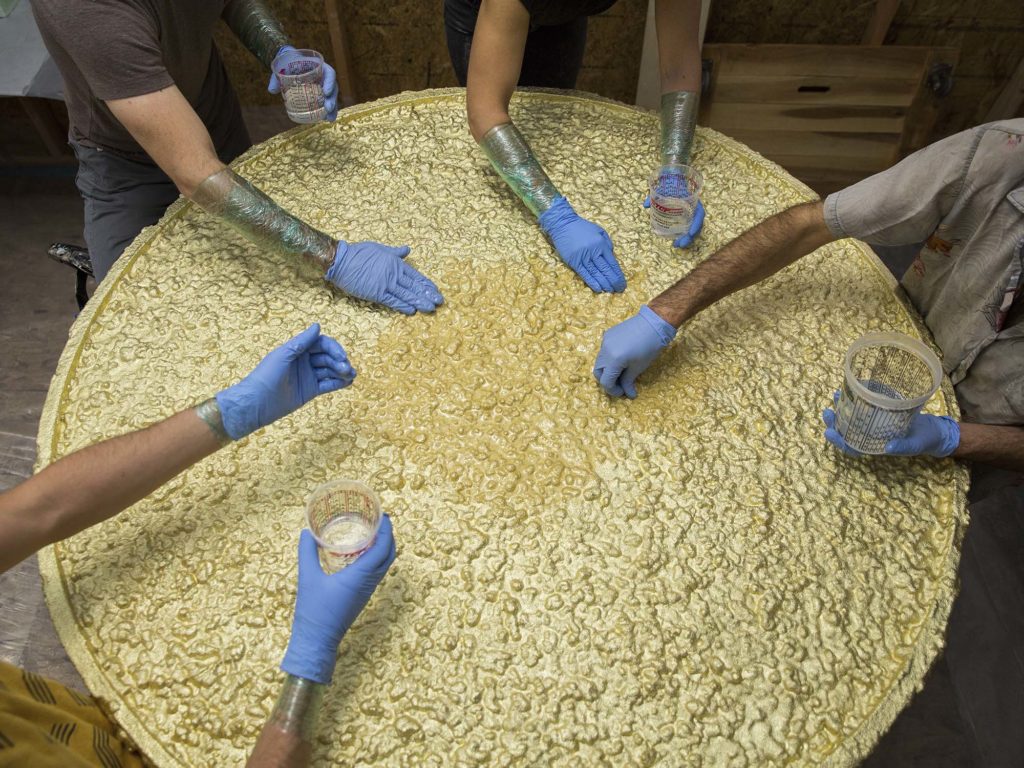
After graduation, Schanck wanted to expand the formal possibilities of his chosen materials, so as to achieve the most compelling surface possible. This inaugurated a period of intense experimentation, driven by the inherent logic of his unconventional materials (and that experimentation continues unabated to this day). As he undertook this process of refinement, he realized he needed help. Lots of help. His first move was to hire people who lived on his own street. One thing led to another, and eventually he found himself the proprietor of a business employing many people from Detroit or elsewhere in Michigan, either full- or part-time.
By now the studio has become a quasi-public space, with an astoundingly diverse crew. Former art students work alongside women from the local Bangladeshi community, which is so thriving that the neighborhood boasts a quasi-official road sign that reads “Welcome to Banglatown.” On the day I visited, preparations for the upcoming show at Friedman Benda were at their peak; the activity was intense, yet its rhythms were more meditative than efficient. Seven women sat round a large table, placing and polishing bits of bronze-colored foil; their headscarves, shot through with metallic threads, seemed almost to declare allegiance to the cause.
Schanck has worked hard to establish this egalitarian production scenario, utopian in its contours. He thinks a lot about the nature of this structure, and the terms on which it is sustained. When his work is shipped to a New York gallery or to a design fair, it takes a journey from one world to another. The creative energies of the Detroit neighborhood are released out into the market, resources flow back in return, and the cycle keeps going. In an idealistic sense, one could perhaps see the people who buy Schanck’s furniture as his final collaborators, no more or less important than each of the artisans.
In another sense, of course, his works inhabit the real world. They are made in a rough corner of a rough city in which poverty presses in on every side. In this place, he is concentrating enormous human capital in the making of luxury objects. By Detroit standards, too, he is an arriviste. So he is reluctant to claim too much authority to speak for the city, or its various communities. Yet, on multiple levels, he is deeply engaged with the place and people around him. One might even think that the furniture is in some way a pretext. Perhaps the studio itself is his real work of art?
I asked Schanck how he navigated all this complexity, and he replied: “slowly and carefully.” To this I might add: imaginatively. Unhomely signals (even in its title) his desire to use the logic of displacement, and the tools of fiction. The exhibition is made up of chairs, tables and sideboards. They are domestic forms, but they also seem utterly alien. For a while now, Schanck has been pursuing an aesthetic that looks both forward and backward in time – equally suggestive of a primordial ur-furniture made of stone, wood or ice, and a sci fi domain in which strange beings sprawl lavishly on structures of pure energy. Narratively, these works gesture toward another place and time. Materially, they always point back home. They are utterly of here and now: Detroit, 2018.
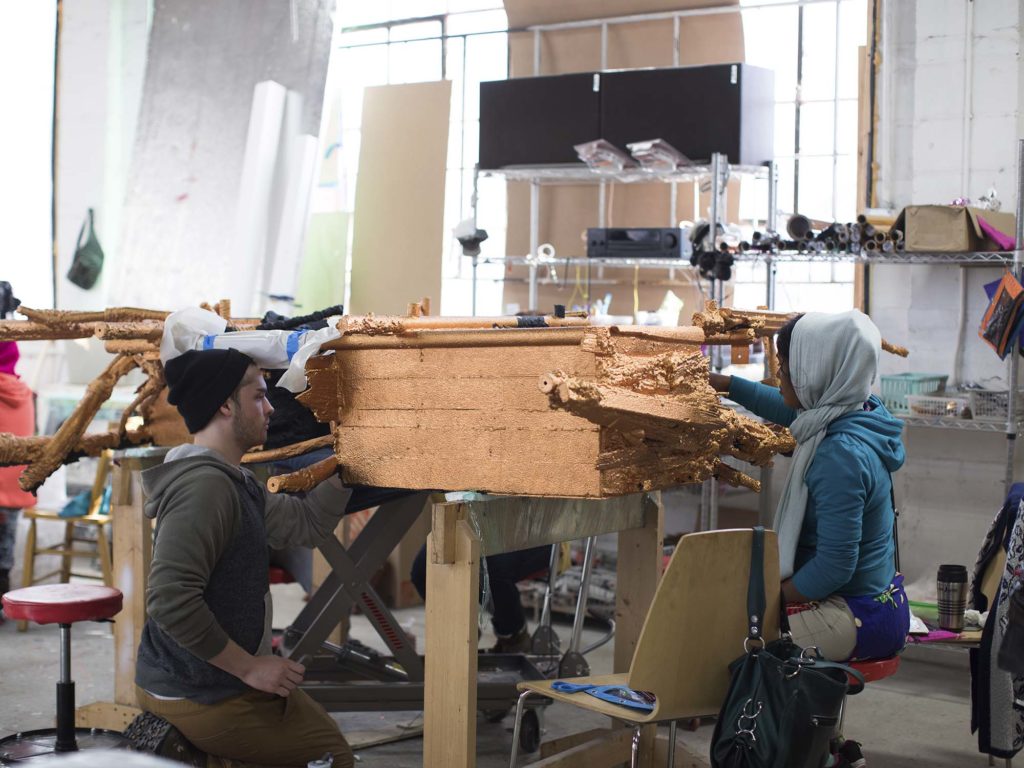
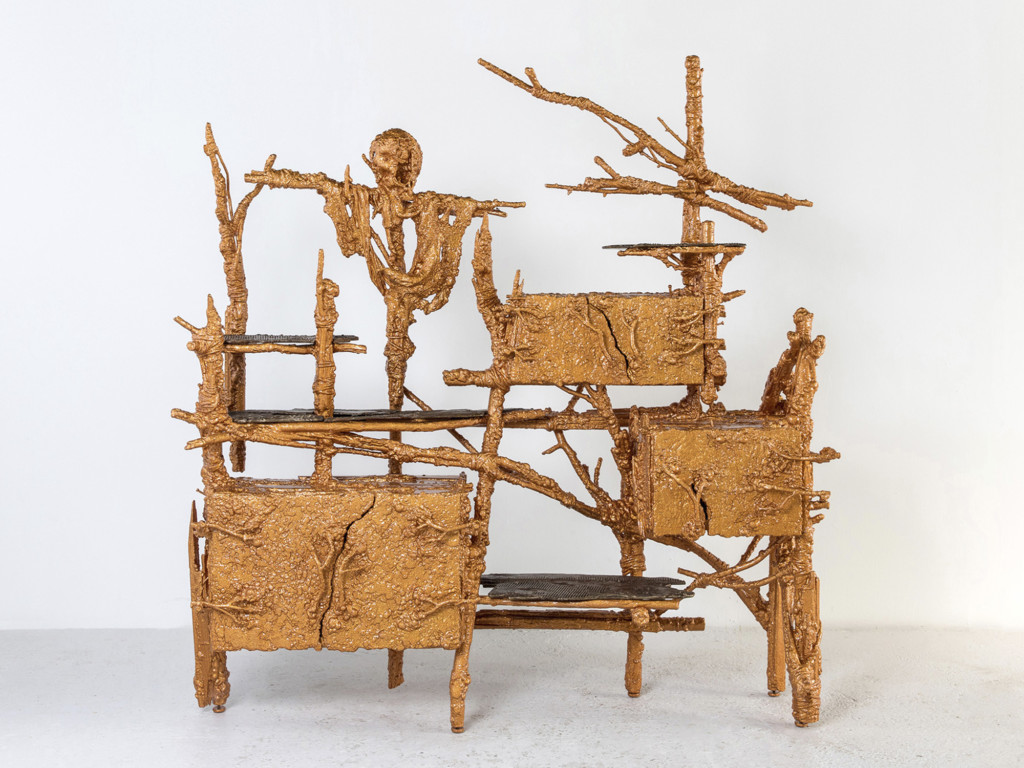
So, back to reality: what actually happens in Schanck’s studio? The first step is the fabrication of a welded steel armature. On to this is packed a collage of hand-shaped foam blocks, and sometimes sticks or other objects. This sculptural substrate is caulked at the seams, then sprayed with a black resin coating. At that point the object is already physically robust – but the work has just begun. More caulk, slightly thinned with water, is massaged into the surface. This modulates the surface so that the foil can be applied, much as a bole might be prepared for gold leaf. Rather than standard kitchen foil, which is thick and unwieldy, he now employs a paper-thin foil taken from the confectionary industry – the material is normally used for chocolate wrappers. In addition to the delicate wrinkly texture this finer material imparts to the work, it is available in a wide range of intense, jewel-tone colors. The foil is applied in small pieces, using customized tools including short-bristled brushes and polishers. Sometimes, selected areas are upholstered, or flocked. Finally the piece receives a further overall coat of clear resin. All the materials involved are inexpensive and widely available, but together they combine to achieve a faux glamour, like non-precious specimens in a Hall of Minerals.
I enumerate this lengthy process only because every step is executed by a different part of the crew. Several of the stages described above – the welding of the armature, the initial resin spray, and upholstery – are executed by trusted partners outside the studio, some around the block, others way out in rural Michigan. The complex stratigraphy of the objects is a result of this extensive collaboration, and a metaphor for that collaboration, too. Once finished at last, the objects seem to glow with an inner light, as if all the energies expended on them had been trapped in amber.
In conversation with the foil team, I came to realize how much they did indeed identify with the project, and how much they were contributing to it. Between them, they have invented innumerable tricks of the trade, often adapting hand tools to make them better suited to the task. A woman called Shopna, who has been working with Schanck for more than two years, showed me an Exacto knife she has embellished with stripes of foil, each stripe marking a piece she has worked on. It is a wonderful and poignant object, a handheld archive of her time at the studio.
At one point, the women at work on the foiling told Schanck that the table’s top could use a light sanding: there were bumps that were breaking through the foil and slowing down the process. Connor, an omni-competent fellow who could fairly be described as Schanck’s right hand man, immediately swooped in with a disk sander. The women briefly stepped aside, chatting amiably amongst themselves, and then got back to it. The whole exchange was like an impromptu dance. Such moments of collaboration are like an optimized, artisanal echo of the Detroit automotive industry, with its intricately choreographed robotic assembly lines. While there is an overall strategy, it is open to constant revision. Quality control and morale are inextricable; everyone shares in the responsibility.
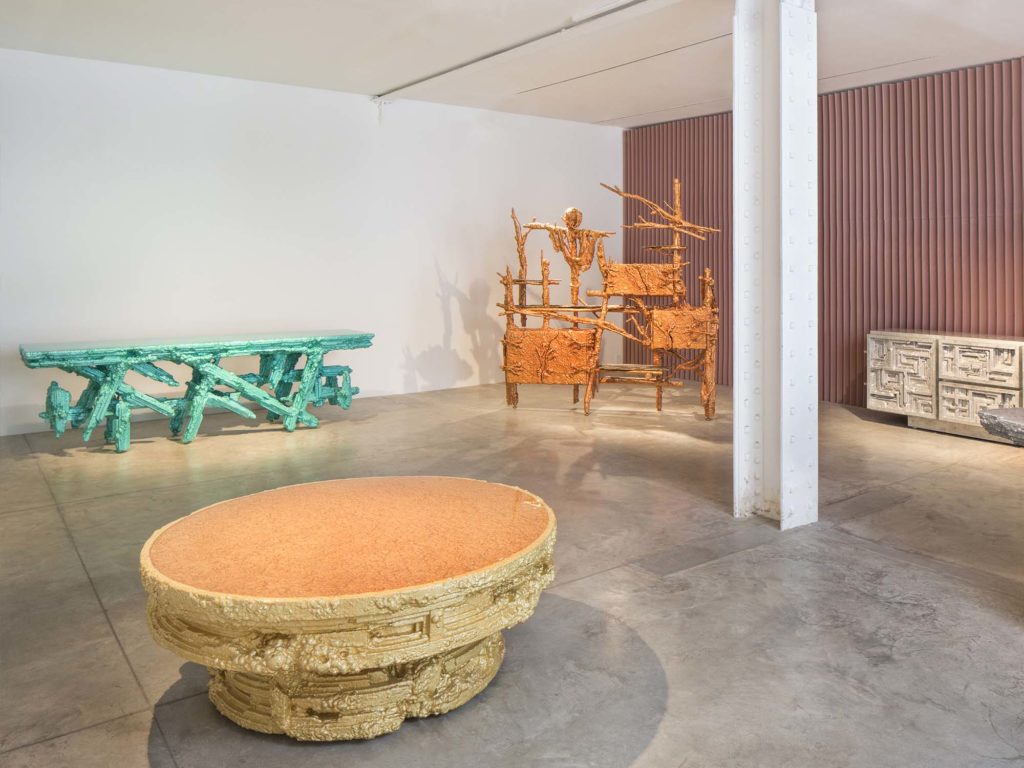
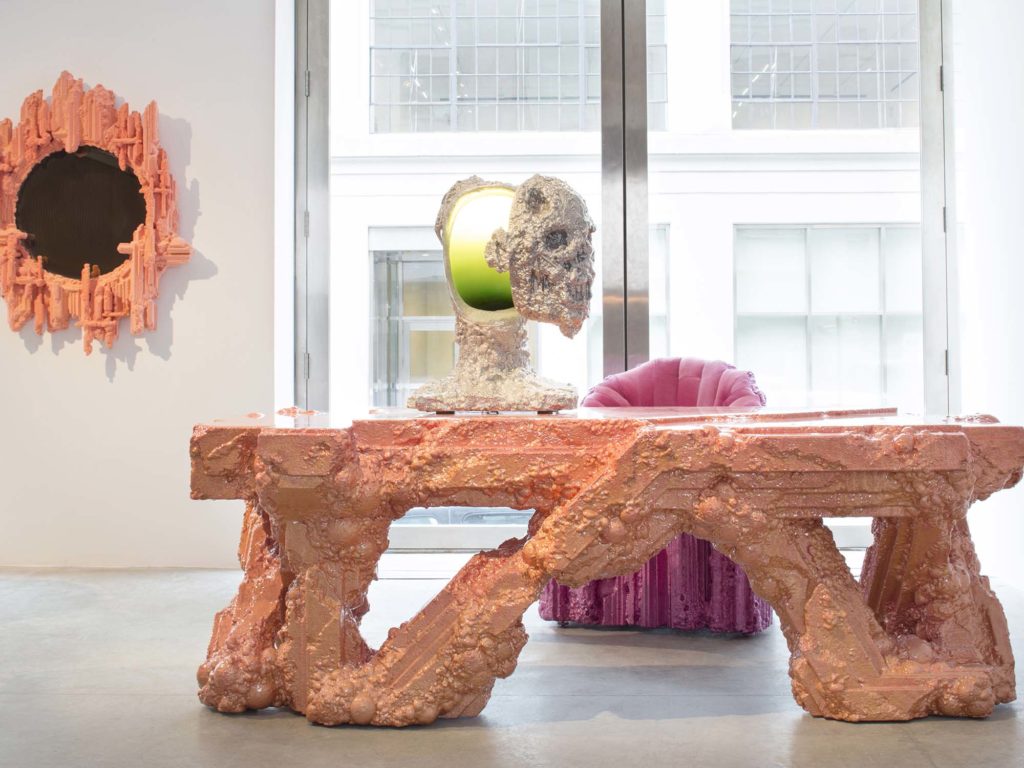
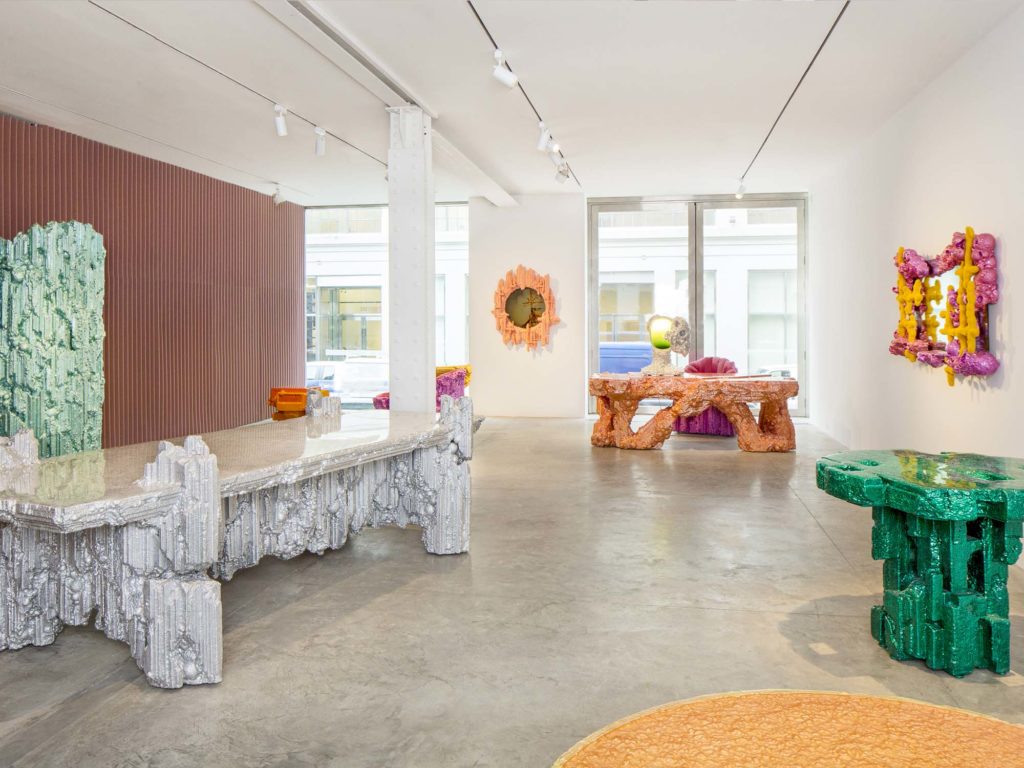
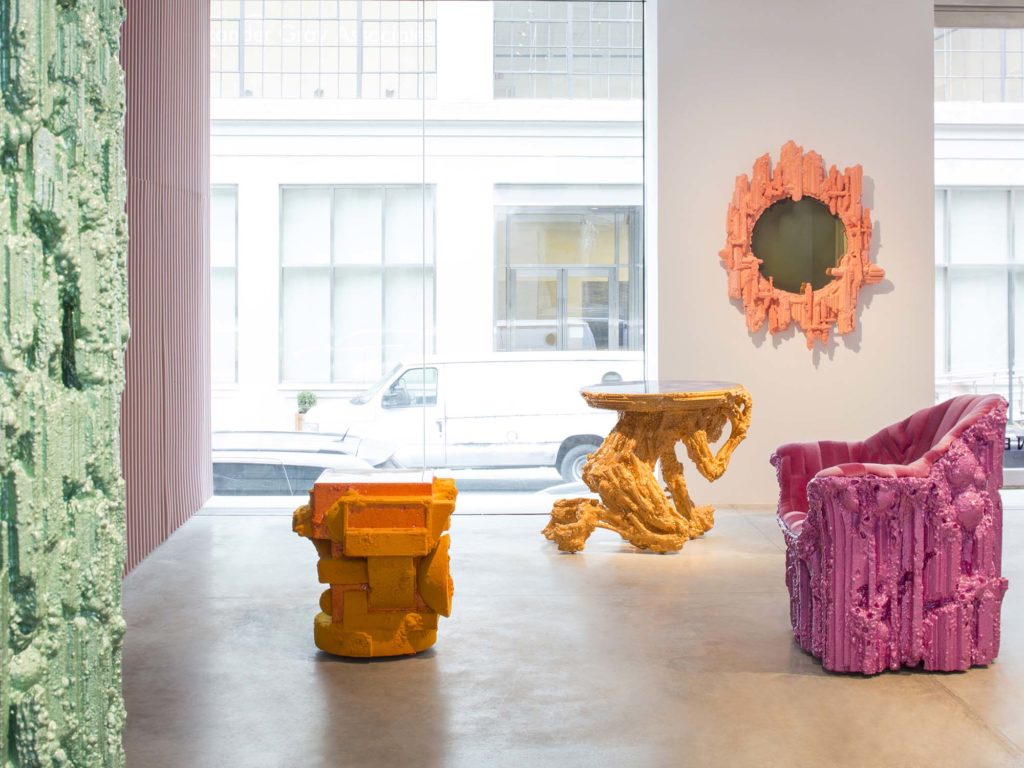
Unhomely also speaks of Schanck’s joint enterprise in a different way: it marks his first foray into figuration. The presence of the body is new in his work, but already remarkably assured, animated by a fusion between the furniture and the people behind it. One table features a life-sized male figure, based on a 3D scan of one of the studio’s artisans. He stoops to the ground, supporting the top on his bowed back. A hand curls up, as it to steady the table edge. The pose immediately prompts thoughts of subjugation – and of precedents like Allen Jones’ Pop Art furniture of the 1960s, or huge baroque cabinets propped up by allegorical figures. Yet the image is also remarkably affecting. The table is built not out of Schanck’s usual carved foam blocks, but little bits of wood, some impaled with nails, giving the figure the air of a martyred saint. These fragments have been gathered from the neighborhood, and in this way the table bespeaks its origins in the local, the humility of that circumstance. Yet it has been sheathed in gold. Even more than usual in Schanck’s work, we have here an alchemical image, in which base materials have been elevated into something extraordinary, while still maintaining rooted to the ground.
A second figural presence in Unhomely is still more provocative. Over a sideboard of limber construction, all rough angles and boxes, presides a skeletal, shrouded form. You may think you know how to read this image straight off, but quite likely, you are mistaken. It is not something out of gothic horror; nor is it (as I myself first assumed) a quotation from Detroit’s African Bead Museum, or some other visionary art environment. Rather, the figure alludes to the scarecrows that the city’s Bangladeshi families erect in their backyard garden plots. Typically, these scarecrows are impromptu affairs, little more than a crotch of sticks and some old clothing.
Schanck’s rendering of the motif preserves some of that informality. His goal was to put the neighborhood into his work, not just in the form of labor, but also symbolically. When he resolved to integrate the scarecrows into his work, he asked his team of foil specialists to build the first figure study. He adapted this design, and then sought their feedback again – an iterative process familiar in other design contexts, but rarely involving such cross-cultural dialogue. Schanck is acutely aware that the inclusion of the scarecrow could be seen as appropriation – as laying unjustified claim to a local community’s story. Yet we might turn that question on its head: would it be better if he did not involve his team’s lives and creativity more fully in his work? In this piece, he seems to be initiating a new thought process, in which Detroit communities not only form the productive base for his work, but are also portrayed within it.
It will be interesting to see where this line of thinking goes. In the meantime, Unhomely unfolds in its beguiling interplay of place and displacement. At the beginning of this essay, I referred to the role that Schanck’s neighborhood played in supporting the American auto industry. It would be a cruel understatement to say that this contribution has not been honored. As a society, we have allowed many places like this to fall into neglect. Back in the glory days, Detroit was filled with companies like Svenksa Tool. The general public probably never appreciated their know-how, and today they are all but forgotten. Now the contingencies of the landscape have shifted again, to a situation still precarious, but also newly promising. It’s a striking thought that, just as the nation’s gleaming cars once condensed the creative energies of this neighborhood, Schanck’s furniture does the same today. Peer deep into these objects, as if looking under the hood of an automobile, and you’ll see what drives his designs forward: respect.
This essay was originally published in exhibition catalogue Chris Schanck: Unhomely, Friedman Benda, New York, NY, March 2018.
